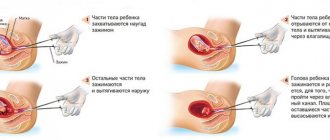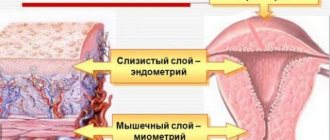Consequences of curettage during a frozen pregnancy
When curettage there is a risk of complications
during or immediately after the procedure, or some time after the operation.
Early complications include:
- Opening of bleeding;
- Perforation (damage) of the walls of the uterus;
- Cervical injuries;
- Remains of the membranes of the fertilized egg in the uterine cavity.
After curettage surgery, menstrual dysfunction
. If menstruation does not come for several months, it is necessary to be examined by a gynecologist for the presence of pathologies caused by the mechanical curettage procedure. This may be due to excessive removal of the mucous membrane, or to a blockage of the cervical canal.
If a canal occlusion is diagnosed, a procedure for widening the cervical canal using medical instruments is prescribed. The following is a course of antibiotics.
Injuries to the cervix and uterine mucosa are fraught with the development of gynecological diseases.
In addition, in the first time after surgery, the risk of infections increases, so during this period a woman must carefully maintain hygiene and maintain sexual peace.
Bloody discharge after curettage lasts up to 2 weeks; in the first 3–4 days it is more abundant, then the amount of discharge decreases and in subsequent days it becomes spotting.
If after 5–6 days the discharge intensifies and clots appear, this is a symptom of the remainder of the membranes in the uterine cavity. Their presence may be indicated by pain in the lower abdomen. Remains of the fertilized egg in the uterus are diagnosed through an ultrasound procedure, and if they are present, a repeat scraping procedure with a cuvette is performed.
The acquisition of an unpleasant odor in discharge or impurities of pus indicates the development of an inflammatory process
, which may be caused by infection during surgery or damage to the walls of the uterus.
Pregnancy
Pregnancy after curettage is possible, and often even more likely if the pathological endometrium was removed. Usually, menstruation begins around the third week after the procedure, since during this time the mucous layer of the uterus has time to recover. In this case, the menstrual cycle is completely normalized and becomes regular after about 4 months. In general, it is possible to plan conception within six months after the procedure, but before starting attempts, it is better to consult a doctor.
Progress of the intervention
How long do you need to stay in the hospital?
The curettage procedure for a frozen pregnancy is carried out in a hospital setting in the department of pathology of pregnant women. The woman undergoes surgery 2–3 days after hospitalization.
In the first two days, laboratory tests are carried out: a blood test for the presence of hidden infections, HIV and hepatitis, blood biochemistry, and a general urine test. A repeat ultrasound procedure is required to diagnose a non-developing pregnancy, and a vaginal smear is taken for microflora.
After the procedure, the woman is under the supervision of doctors in the hospital for up to 7 days.
. If necessary, a course of antibiotics is prescribed. The day before discharge, another ultrasound procedure is performed, and repeated blood and urine tests are taken to rule out possible infections. After discharge from the hospital, the woman should visit the attending gynecologist at the clinic at her place of residence.
Conclusion
Curettage is a traumatic but necessary procedure. You cannot avoid it if it was prescribed by a doctor, as it can have unpleasant health consequences. Provided that the recovery period is carried out correctly, complications after curettage are extremely unlikely, and this procedure only has a positive effect on health.
←Previous article Next article →
The loss of a child is a great stress for a woman and her body, so planning a child after a missed pregnancy should take place under the strict supervision of a gynecologist.
Depressed state At the gynecologist The emergence of a new life blood test Waiting for birth Diarrhea For treatment Thrush in a newborn
A woman needs special care from a doctor and loved ones. This tragedy usually unsettles the failed mother, so recovery from a missed pregnancy takes time.
The doctor must not only observe the patient, but also convince her that in the future she will be able to bear a healthy child. It is important for a woman to understand that what happened is not a sentence for the rest of her life. This can happen in the life of every expectant mother.
Perhaps the tragic death of the fetus occurred due to a genetic error. Sometimes external factors are to blame. In any case, if both parents are healthy, they have every chance of giving birth to a healthy baby.
Is it painful to have curettage?
The operation of cleaning the uterus during a non-developing pregnancy is performed under general anesthesia, so no pain is felt during curettage
. After the operation, you may feel slight discomfort in the perineum while walking or urinating, due to mechanical impact.
If, a few days after the procedure, cramping pain appears in the lower abdomen, this is a symptom indicating the remains of the fertilized egg in the uterine cavity.
For diagnosis, an ultrasound procedure and mechanical palpation of the uterus are performed, and if the symptom is confirmed, a repeat curettage operation is prescribed.
Treatment and recovery after the procedure
A frozen pregnancy is, first of all, a huge psychological trauma for a woman. Therefore, along with general treatment, psychotherapeutic assistance is indicated. General treatment includes the prevention of infectious diseases with antibiotics, restoration of hormonal levels and menstruation.
The duration of antibiotic therapy is up to 10 days and is carried out in a hospital setting with intramuscular administration of drugs. To prevent the development of postoperative anaerobic infections, Trichopolum tablets are prescribed.
After the operation, the woman must observe sexual rest for two weeks. You can plan your next pregnancy in 3 – 6 months
. To restore hormonal levels and prevent pregnancy, oral hormonal contraceptives are prescribed for a course of three months.
Before subsequent conception, it is necessary to undergo diagnostics of the body to determine the cause of a missed abortion. The remains of the fertilized egg should be sent for histological examination.
Unfortunately, not all pregnancies end successfully. For a number of reasons, they can be interrupted at a variety of times, in particular due to the freezing of the embryo, which is unable to survive.
In most cases, pregnancy stalls in the early stages, in the first trimester. Sometimes, at a very early stage, the dead fertilized egg comes out of the uterus on its own along with bloody discharge, and in some cases the woman is not even aware of what happened, thinking that her period has come late. At later stages, it is practically impossible to do without the curettage procedure, which allows you to remove the dead embryo from the uterine cavity.
Consequences of fetal freezing
First of all, you need to understand how cleaning is carried out after a frozen pregnancy and whether it is always necessary. Modern medicine offers several methods of interruption:
- medical abortion;
- curettage (curettage);
- vacuum aspiration.
Medical abortion is only used if the dead fetus is only a few weeks old. A woman takes a special drug, after which the uterus begins to contract vigorously and a miscarriage occurs.
Depression after the loss of a child
Cleaning (curettage) after fetal death is a very popular, but undesirable procedure that is harmful to health. The uterine tissue is severely injured and there is a high risk of complications. The operation requires general anesthesia. The doctor installs dilators in the vagina, then inserts a special instrument into the cervical canal, which removes the upper mucous layer. Discharge after a frozen pregnancy is typical for this method. The woman needs to stay in the hospital for some time, because sometimes inflammatory processes develop and bleeding begins.
Vacuum aspiration surgery is performed under local anesthesia or general anesthesia. The uterine cavity is cleaned using vacuum suction. There is no need to insert an expander. The doctor simply inserts the tip of the device into the cervical canal. The patient only needs to be observed for a couple of hours. This method has its advantages: it is more gentle than cleaning and the woman does not need to stay in the hospital.
Preparing the body for conception
Repeated pregnancy immediately after the previous one can cause serious harm to the body, which is greatly weakened after the stress experienced. No matter how much you would like to become a mother, you should not plan a new pregnancy a month or two after a frozen one. First of all, you need to carry out physical and psychological recovery.
First, it’s worth finding out why the fetus died and whether it had genetic pathologies. After curettage, it is necessary to conduct a microscopic (histological) examination of the fetal tissue. The analysis will be able to identify possible mutations in the embryo. Sometimes tragic events occur due to external factors or an unfortunate combination of genes.
A visit to the doctor is required
Recovery takes time. Doctors recommend waiting at least three months before conceiving again. This is the minimum period that must pass. It is best if recovery from a case of fetal death lasts 6-12 months. Just imagine what a serious test the uterus goes through when curettage damages its surface, which is sensitive to mechanical stress. In addition, cleaning can cause cervical erosion. After six months, you need to visit a gynecologist who will analyze the condition of the cervix.
It is important to restore a regular monthly cycle: ovulation and menstruation. Sometimes menstruation after a frozen pregnancy begins a month after curettage and miscarriage, and conception can occur the next month. But don’t rush, give your body a rest. Be sure to use protection, since conception in the first three months after the incident is not recommended. Moreover, until a full examination, the reason for what happened will not be clear.
Pay attention to the discharge that may appear after a pathological pregnancy. If there are too many of them or they have a specific smell, you should consult a doctor. If painful periods occur after a missed pregnancy, this is also a cause for concern.
Even if a sufficient amount of time has passed after an unsuccessful pregnancy, you should not plan a new pregnancy until you are psychologically ready for it. First, discuss this issue with your husband. Discuss all the details and nuances. If necessary, you can seek help from a professional psychologist. This is not at all shameful. A qualified specialist will help you understand yourself, mentally prepare for the next conception and the process of pregnancy.
Waiting for the birth of offspring
Passing the necessary tests
Recovery after a frozen pregnancy is accompanied by testing. They will help identify the exact causes of what happened. Of course, perhaps you and your husband are completely healthy and the death of the fetus occurred due to a tragic coincidence. But it’s better to still do tests after a case of fetal death to be 100% sure.
So, the following tests are needed.
- Flora and sexual infections.
- Blood.
- Spermogram.
- TORCH complex.
- Thyroid hormones.
- Sex hormones.
- Chromosomal, genetic analysis.
Tests for sexually transmitted infections and flora smears are important for the fetus. There are many infections that can stay in the body for several years, but never reveal themselves. However, they can harm the child.
Blood will help the specialist understand the overall picture of health, so it is necessary to conduct a test for blood type, Rh factor, TORCH complex infections, and a general blood test.
Such an unexpected and terrible event as a frozen pregnancy plunges any woman into shock. The body is experiencing a colossal hormonal shock - all its organs and systems were already configured to bear a fetus, and suddenly something went wrong. Restoring the body after a frozen pregnancy has both completely understandable physiological aspects and psychological ones, which are no less important.
It will take time to adjust to the normal, pre-pregnancy level of hormones, to return to the usual menstrual cycle and, most importantly, to achieve a normal psychological state. You will learn in our article how recovery occurs after a frozen pregnancy, how long it will last and how to regain peace of mind.
Is it painful to do curettage during a frozen pregnancy?
Of course, miscarriage is a very unpleasant, and for most women, even a tragic event. But I want to somehow reassure you. Firstly, most likely, the fertilized egg was non-viable, that is, the embryo would not have been able to develop fully in any case. Secondly, curettage in gynecology has been used for a very long time, that is, doctors are well familiar with the intricacies of this procedure, which means there is nothing to be afraid of. Thirdly, many women, after properly performed curettage, restoration and preparation for the next pregnancy, safely give birth to beautiful children in the future!
And yet, curettage is an operation, albeit without opening the abdominal cavity, and it must be taken with the utmost seriousness, that is, the choice of an experienced doctor in this matter is extremely important.
During the curettage process, the fertilized egg and placenta rudiments attached to the female uterus are removed along with the upper layer of the uterine mucosa; they are “scraped out” with special instruments. The operation is quite traumatic, certainly unpleasant, but it is performed under anesthesia, and therefore the woman does not feel pain directly during the operation. In most cases, general anesthesia is used, but in a separate procedure, curettage can be performed under local anesthesia.
After curettage, discomfort and mild pain in the lower abdomen may remain for a short time until the uterine epithelium heals.
About planning your next pregnancy
When a frozen pregnancy was desired for a woman, she experiences severe stress. And then events develop in two ways. Some representatives of the fairer sex immediately ask when the next pregnancy is possible and how to prepare for it, while others cannot even think about another pregnancy. Both ways of thinking are normal. But wanting to conceive again as soon as possible is unreasonable. Yes, the woman has already gotten used to the image of the future mother, made plans, came up with a name for a boy or girl. But in any case, the rapid onset of the next pregnancy again threatens with serious pathologies and a repetition of the tragic scenario.
The first thing to do is find out. If fetal fading was caused by bad habits, infections, hormonal disorders, then the chances of repeated pathological development of the fetus are high. Two or three missed pregnancies in the past set the body up for habitual miscarriage. This is a pretty serious diagnosis. It is difficult to treat even after eliminating risk factors. The female uterus, out of habit, will reject the embryo at the same gestation period. This is precisely what women who are in no hurry with their next pregnancy are subconsciously afraid of.
The first priority should be a comprehensive examination, physiological and psychological recovery.
As for the next pregnancy, this, according to gynecologists, should happen no earlier than in 6 months.
Curettage during a frozen pregnancy: discharge
After curettage, an open wound remains on the surface of the uterus, which bleeds. Of course, during the healing process, spotting from the vagina is considered normal, but it should not be prolonged. The recovery period after such an operation does not last the same amount of time for all women. However, gynecologists emphasize: bleeding usually stops within a few days. And the next menstruation usually begins a month later or a little earlier.
If after bleeding, spotting is observed for a long time, and especially if it has a brown color and an unpleasant putrid odor, then you should urgently consult a doctor - there is a high risk of developing an infection. In addition, it is quite possible that chorionic cells remain in the uterine cavity, and you will need to take a repeat blood test for hCG.
A mandatory medical examination must also be completed if, after curettage, a woman observes the appearance of painful symptoms:
- severe pain attacks in the perineum and lower abdomen;
- weakness, dizziness;
- nausea, lack of appetite;
- chills, body aches;
- increase in body temperature.
In the first two days after surgery, a slight increase in body temperature (not exceeding 37.5 o C) may be normal, if then the temperature drops and the woman feels better. If it increases or remains at elevated levels for more than 2-3 days, then you definitely need to tell your doctor about it.
In general, even if bloody clots come out of the vagina, this is not scary - the uterus is cleansed. But only on condition that the woman feels quite well. It is recommended to move more, stimulating better discharge of bloody accumulations and contraction of the uterus. Sexual relations can be resumed immediately after the discharge has stopped, but it is better to protect yourself from pregnancy for six months. In the meantime, you should find out the reason why the fading occurred and prepare properly for the upcoming conception.
Lifestyle in a broad sense
A variety of factors can be detrimental to a baby. External environment: environmental problems of the region, weather anomalies, harmful working conditions of one or both parents, etc. More specifically, it is dirty air and water, changes in temperature and atmospheric pressure, chemically active substances in the environment and other negative impacts.
The expectant mother should not overuse sunbathing and long journeys, and even more so, air travel; this is also noted by doctors as one of the reasons why pregnancy falters.
Stress is far from the best emotional background for a baby; the mother and her environment should remember this. A sedentary lifestyle, lack of oxygen, excessive use of computers, poor or simply unbalanced nutrition.
Individually, these risks are unlikely to be fatal, but taken together they can greatly harm the baby and the mother herself.
A separate topic is bad habits: smoking, drugs, alcohol. This is the strictest taboo for all responsible mothers! Nothing can justify such “indulgences,” which are extremely dangerous for the development of the child and his very existence.
Most often, a frozen pregnancy is caused by a combination of several factors. Still, nature took care of protecting human offspring by creating a number of barriers to risks. Separately, any of the above reasons for concern rarely becomes disastrous for the baby. But taken together, they can lead to disaster.
Therefore, mommy needs to be attentive to herself and the heir, and do not hesitate to consult a doctor in case of the slightest discomfort or concerns. And be sure to follow all his instructions. Then you will be able to track the problem in time at the initial stage and, together with the doctor, cope with it or, at least, avoid serious complications.
This concludes today's important conversation about the causes of this most dangerous pathology. Love yourself and your future baby! Use all available means so that he is born healthy and makes you and your family happy! See you again!










